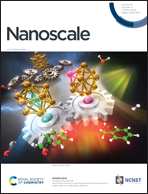Gradient oxygen doping triggered a microscale built-in electric field in CdIn2S4 for photoelectrochemical water splitting†
Abstract
Construction of a built-in electric field has been identified as an attractive improvement strategy for photoelectrochemical (PEC) water splitting by facilitating the carrier extraction from the inside to the surface. However, the promotion effect of the electric field is still restrained by the confined built-in area. Herein, we construct a microscale built-in electric field via gradient oxygen doping. The octahedral configuration of the synthesized CdIn2S4 (CIS) provides a structural basis, which enables the subsequent oxygen doping to reach a depth of ∼100 nm. Accordingly, the oxygen-doped CIS (OCIS) photoanode exhibits a microscale built-in electric field with band bending. Excellent PEC catalytic activity with a photocurrent density of 3.69 mA cm−2 at 1.23 V vs. RHE is achieved by OCIS, which is 3.1 times higher than that of CIS. Combining the results of thorough characterization and theoretical calculations, accelerating migration and separation of charge carriers have been determined as the reasons for the improvement. Meanwhile, the recombination risk at the doping centers has also been reduced to the minimum via optimal experiments. This work provides a new-generation idea for constructing a built-in electric field from the view point of bulky configuration towards PEC water splitting.

- This article is part of the themed collections: 2024 Nanoscale HOT Article Collection and Nanoscale 2024 Emerging Investigators


 Please wait while we load your content...
Please wait while we load your content...